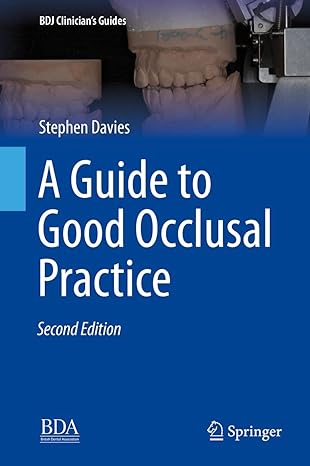Stephen Davies
This book considers occlusion within the different disciplines of clinical dentistry, taking into account the challenges specific to each, in order to develop guidelines of good occlusal practice (GGOP). The GGOP for each discipline has benefited from an authoritative contribution of a recognised specialist in that field. Readers will find full description of what constitutes good occlusal practice in, for example, simple and advanced restorative dentistry, removable prosthodontics, the restoration of the worn dentition and implantology. It is clearly explained why and how the GGOP differ in the various branches of dentistry, the key point being that it is the support for the occlusal surfaces that determines GGOP. One of the foundations of this work is that an occlusion can only be judged by the tissue reactions to it: there is no such thing as an intrinsically bad occlusion or malocclusion.
Today it remains the case that many dentistsfeel that occlusion represents an important gap in their knowledge; indeed, some qualify with little more than the belief that “occlusion is important”. Their vulnerability in this area of clinical practice is confirmed when early cases fail to go as well as hoped. In providing comprehensive guidance on good occlusal practice in different contexts, this book will be of value for a wide range of dental practitioners.
Download
Note: Only Dental member can download this ebook. Learn more here!
Related Books
 Orofacial Pain: A Clinician’s Guide
Orofacial Pain: A Clinician’s Guide Science and Practice of Occlusion
Science and Practice of Occlusion Practical Applications in Dental Occlusion: Analog to Digital
Practical Applications in Dental Occlusion: Analog to Digital Veneers: Fantasy | Risk | Success
Veneers: Fantasy | Risk | Success Managing Orofacial Pain in Practice
Managing Orofacial Pain in Practice Condylography: Recording and Analysis
Condylography: Recording and Analysis The Vertical Dimension in prosthesis and orthognathodontics
The Vertical Dimension in prosthesis and orthognathodontics Clinical Cases in Orofacial Pain
Clinical Cases in Orofacial Pain Temporomandibular Disorders : A Translational Approach From Basic Science to Clinical Applicability
Temporomandibular Disorders : A Translational Approach From Basic Science to Clinical Applicability Advanced Strategies for Tooth Extraction in Dentistry: Beyond Basics
Advanced Strategies for Tooth Extraction in Dentistry: Beyond Basics


